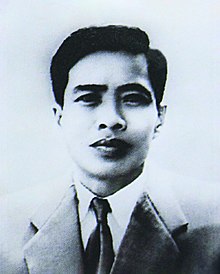Phạm Hùng (June 11, 1912 – March 10, 1988) was a South Vietnamese politician and the 2nd Prime Minister of the Government of the Socialist Republic of Vietnam from 1987 to 1988.[1]
Phạm Hùng | |
|---|---|
 | |
| 2nd Chairman of the Council of Ministers | |
| In office 18 June 1987 – 10 March 1988 | |
| President | Võ Chí Công |
| Preceded by | Phạm Văn Đồng |
| Succeeded by | Võ Văn Kiệt (acting) |
| Personal details | |
| Born | 11 June 1912 Vĩnh Long Province, French Indochina |
| Died | 10 March 1988 (aged 75) Ho Chi Minh City, Vietnam |
| Political party | Communist Party of Vietnam (1930–1988) |
| Military service | |
| Branch/service | Vietnam People's Public Security |
| Rank | |
Life
editPhạm Hùng was born on June 11, 1912, in Vĩnh Long Province, in the Mekong River Delta of southern Vietnam. He was a member of the Communist Party of Indochina since 1930. The following year, he was arrested by the French colonial authorities for killing a landowner and sentenced to death. His sentence was converted into a prison sentence. In 1936, he was amnestied. He was arrested again in 1939 and remained imprisoned until 1945 on the infamous prison island Poulo Condore. During his imprisonment, he is described as one of the leaders of the communist prisoners. During the First Indochina War, he was one of the active party leaders in the south of the country and although in a formally subordinate position, controlled large sections of the Viet Minh security forces in the south. In 1951, he was appointed as a member of the Central Committee of the party.[2]
After the withdrawal of France and signature of Geneva Accords, Pham Hung was ordered in 1955 to Hanoi. In 1957, he became a member of the Politburo of the party.[3]: 100 He was closely allied with Lê Duẩn who by early 1964 had become the effective leader of North Vietnam. Lê Duẩn and his supporters adopted a more belligerent approach to the armed struggle in South Vietnam in contrast to moderates such as Ho Chi Minh and Võ Nguyên Giáp.[3]: 108–10
In July 1967, after the mysterious death of Lê Duẩn ally, Nguyễn Chí Thanh, under the code name Bay Cuong, he took command of the Central Office for South Vietnam (COSVN).[3]: 154
After the war, he returned to his role in the Politburo. In 1979, he became Minister of the Interior. In 1987, he took over the post of prime minister after the withdrawal of Phạm Văn Đồng.[4]
During the Vietnam War, he acted as political commissar to the National Liberation Front of South Vietnam. He also served as Interior Secretary before his relatively brief period as Prime Minister.[5]
References
edit- ^ Ronald B. Frankum Jr. Historical Dictionary of the War in Vietnam 2011 p.357 "Phạm Hùng (1912-1988). Born Phạm Van Thién and also known as Bay Cuong, Phạm Hùng joined the Indochinese Communist Party in 1930 after being expelled from school for his radical activities two years earlier. "
- ^ Jacques Dalloz : Dictionnaire de la Guerre d'Indochine, Paris, 2006, S. 195 Christopher E. Goscha: Historical Dictionary of the Indochina War (1945–1954) – An International and Interdisciplinary Approach. Kopenhagen 2011, S. 169f
- ^ a b c Asselin, Pierre (2018). Vietnam's American War A History. Cambridge University Press. ISBN 978-1107510500.
- ^ Bruce L. Lockhart, William J. Duiker : Historical Dictionary of Vietnam, Oxford, 2006, S. 304
- ^ Obituary at the New York Times
External links
edit